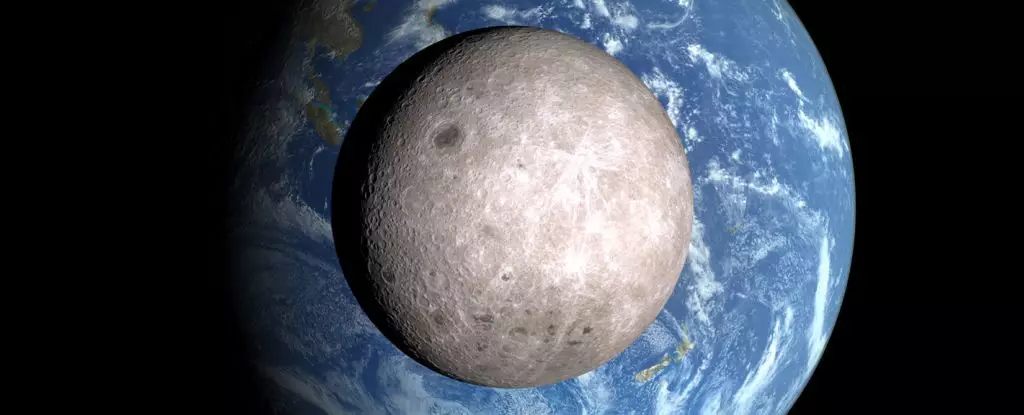The Moon has long captivated scientists and dreamers alike, serving as a beacon for exploration and curiosity. However, recent findings expose a stark difference in the water distribution across its surface that challenges long-held assumptions about our celestial neighbor. The evidence suggests that the side permanently facing away from Earth, often dubbed the “dark side of the Moon,” is not only less illuminated by sunlight but also distinctly lacking in one of the key ingredients necessary for life: water. This unsettling imbalance compels us to reconsider our understanding of the Moon’s geology and formation, posing deeper questions about the history of our solar system.
Cratered and Waterless: The Far Side’s Identity Crisis
Scientists have meticulously analyzed lunar materials sourced from the far side through China’s Chang’e-6 mission, uncovering significant disparities compared to the Moon’s near side. The far side, renowned for its heavily cratered surface, stands in stark contrast to the near side’s flat, basaltic plains called maria. This discrepancy begs the question: how can two halves of the same celestial body boast such opposing characteristics? The newfound evidence reveals a far side that is not merely visually different; it suffers from a scarcity of water, which poses profound implications for our understanding of lunar evolution.
Studies led by researchers Huicun He and Linxi Li present compelling evidence that the lunar mantle may hold the key to unraveling this mystery. The inconsistencies in water distribution reflect an evolutionary story intertwined with the most cataclysmic events in our solar system’s history, specifically the colossal impact theorized to have formed the Moon. Water, in this context, is not just a trivial element; it is a testament to the violent forces that shaped our cosmic neighbor.
The Giant Impact Hypothesis: A Flawed Legacy?
The prevalent theory explaining the Moon’s origin—the giant impact hypothesis—maintains that a body the size of Mars, named Theia, collided with the proto-Earth over 4.5 billion years ago. The debris from this cataclysmic event is believed to have coalesced into what we now call the Moon. However, if the impact scenario left the far side bereft of water, can we still trust this widely accepted narrative? The implications of a drier far side suggest that our understanding of lunar formation may require realignment with the geological anomalies evident on the Moon’s surface.
This new research points toward uneven cooling that resulted from the Earth exerting gravitational influence over the Moon during its early formation. The evidence indicates that the crust of the near side is thinner, allowing for significant outpouring of magma, resulting in the formation of the maria. This estrangement of materials highlighted by the water differential can be perceived as a metaphor for humanity’s own tendency to overlook disparities and inequalities—an irony that reveals the Moon itself as a reflection of earthly relations.
Water: A Key Element with Cosmic Implications
Water’s presence, or lack thereof, serves as a linchpin for not only geological compositions but also the potential for future exploration and habitation. The findings implicate that much of the water found in the Moon’s mantle appears to be concentrated on the near side. This geographic disparity constrains opportunities for lunar exploration, emphasizing a need for a broader understanding of the far side’s resources. Without accessible water, the prospect of establishing a sustainable human presence on the Moon remains unpredictable—bounded by scientific discoveries that govern the viability of extraterrestrial settlements.
Analysis indicates that the thin crust on the far side could have resulted in volcanic activity being stifled, leading to basalts that showcase a stark drought-like state. The findings from the Chang’e-6 mission shine a light on the geological complexities of the Moon, hinting that the far side may, at times, harbor moisture—but in far lesser quantities than its near counterpart.
A Call for Broader Exploration: The Quest for Truth
This contrast invites a renewed commitment to exploring the far side of the Moon. For too long, the narrative surrounding lunar exploration has favored the near side, perhaps due to its accessibility and abundance of resources. Nevertheless, the far side’s unique geological history holds potential answers to questions that have plagued scientists for generations.
As the scientific community wrestles with implications of this research, there emerges a palpable excitement tinged with urgency: the cosmic puzzle of the Moon’s origin, replete with unanswered questions, beckons us to embark on new missions and gather more samples. Water—or the lack thereof—could illuminate the intricate tale of our natural satellite’s formation and evolution. Such discoveries not only aid our understanding of the Moon but may also serve as a critical stepping stone in humanity’s quest to explore the final frontier.


Leave a Reply